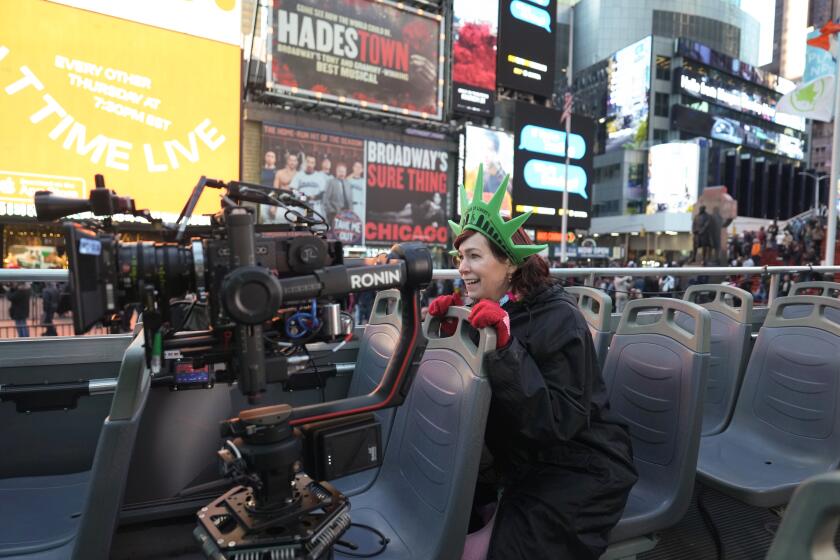Opinion: Studio productions keep moving out of Los Angeles. We need to stop the bleeding

There’s no business like show business — but in Los Angeles, it feels like there’s no business at all.
If that sounds melodramatic, consider this: The Art Directors Guild, a labor union representing about 3,000 film workers including set designers, art directors and many other artists, has suspended a training program and issued a statement explaining that “we cannot in good conscience encourage you to pursue our profession while so many of our members remain unemployed.” The guild’s pessimism is a reaction to Hollywood’s decline, which is reaching a critical point for the industry and Southern California.
New York is doubling down on film and TV to compete with its main rival, L.A., for a bigger slice of the Hollywood pie — even as the industry is struggling to rebound.
For the record:
10:28 a.m. May 22, 2024A previous version of this article incorrectly stated that the Art Directors Guild had stopped accepting new members because 75% of current members were unemployed. It is taking applications but has suspended a training program. The guild says that it does not have precise figures on members’ employment.
When the writers’ strike of 2023 ended, many of us in the industry felt excited about new opportunities and getting back to work. But production has yet to return to pre-strike numbers. I was champing at the bit to start taking pitches out, only to discover that it was harder than ever to get staffed, put a new series into production or even get into a room to pitch.
While commiserating with other writers and other film workers in Southern California, I found that I wasn’t the only one struggling to find work. Practically everybody I talked to in the industry had a similar story: They had the sense that fewer productions were being greenlit, which means less work for thousands of people — and those shows that are happening are increasingly being made outside of Los Angeles.
Film and TV writers of varying experience levels are struggling to find work after the Hollywood strikes amid an ongoing industry contraction.
Production has been slipping away from Hollywood since the 1950s, but the effects have never been more apparent than at present. Other regions in the United States, Canada and Europe have steadily increased incentives to attract TV shows and movies, leaving California in the dust. Georgia (which is where many Marvel TV shows and movies are shot) offers up to 30% in transferable tax credits on film and TV production costs, plus an additional 10% increase on the base tax credit if the project includes a Georgia promotional logo. Actors, directors and crew prefer to stay close to their homes in Los Angeles to film, but it’s hard for studios to pass up getting a third of their money back if they film outside of California.
Our state has fallen far behind in the tax-break arms race.
Even as California lost a huge volume of production to other locations, there was still plenty of film production taking place in Los Angeles before this year — sufficient work that many people could make a living in the industry. We were kept afloat by “peak TV”: the glut of content that was required by the explosion of streaming services.
But 2022 was the peak of peak TV. Back then platforms such as Netflix, Amazon and Apple TV hemorrhaged billions of dollars to generate content to attract new subscribers, resulting in 633 scripted series being released that year. As the streamers’ emphasis changed from subscriber growth to profitability, prices for the services went up and the number of new shows went down to 481 released in 2023, with the number expected to dip into the 300s within a few years.
In other words, we’re about to really feel the pain from losing productions to Georgia, Canada and Eastern Europe. And I don’t mean “we” as in artists and industry creatives — I’m talking “we” as in all of California.
As TV and movie productions slowly come back after the writers’ and actors’ strikes, they’re nowhere near the volume of 2022 — and for the most part, nowhere near Los Angeles. Disney has 22 live-action movies slated for production in 2024, with only three to be filmed in California. Other studios such as Sony, Warner Bros. and Universal Pictures are following the same script and taking the majority of their production dollars outside of California.
New York, already one of California’s biggest competitors, just announced a huge increase to its film tax credit program, making filming in New York even more attractive.
Los Angeles has been a great partner to filmmakers for decades because of our sunlight, studios and locations — all of which have built up a critical mass of world-class local talent in front of and behind the camera. But we must now do more to keep Hollywood in Hollywood.
The California Film Commission, a state government agency, recently awarded $152 million in tax credits for 12 television projects. That $152 million is expected to bring in a return of $1.1 billion in revenue for in-state local workers and businesses while employing 2,300 crew members, 2,200 cast members and thousands more background performers.
Since 2009, the commission’s Film and Television Tax Credit Program has enticed 33 TV series to relocate to California. The biggest relocation get is the Amazon series “Fallout,” which was lured away from New York and is expected to bring in $153 million in qualified expenditures (money spent on crew and staff salaries, locations and rentals in the state of California) and employ around 170 cast and crew. The program has a budget of $1.55 billion for five years, set to run through 2030-31.
Can we do better than that? We’re going to have to if we want to remain the center of film production employment, maintain a strong and vibrant workforce and keep the billions in revenue flowing into our economy from the film industry.
If productions in Southern California dip below a critical level for too long, the industry’s essential talent will drift away along with enormous sums of revenue. Persuading studios to film here would become much more challenging if we couldn’t offer a deep bench of local film workers, on-screen talent and local businesses that support the entertainment industry.
That’s why the California Film Commission and its Los Angeles counterpart, FilmLA, should act now, before it’s too late. Those agencies and other government bodies should dramatically improve incentives to keep our current shows and attract new productions to Los Angeles. Let’s go on with the show … and make sure the show doesn’t go on without us.
Ivan Ehlers is a writer, artist and director as well as a contributor to the New Yorker, Mad Magazine and the Wall Street Journal.
More to Read
A cure for the common opinion
Get thought-provoking perspectives with our weekly newsletter.
You may occasionally receive promotional content from the Los Angeles Times.












